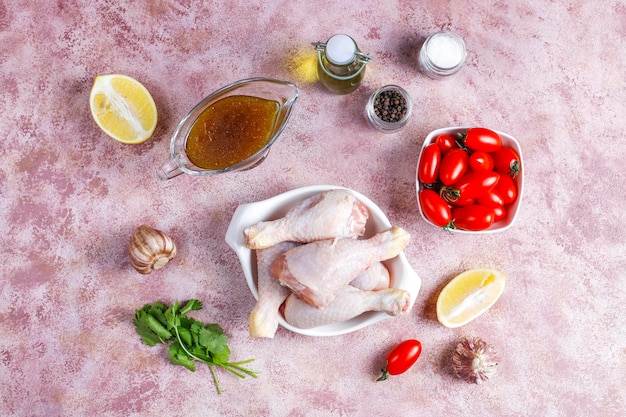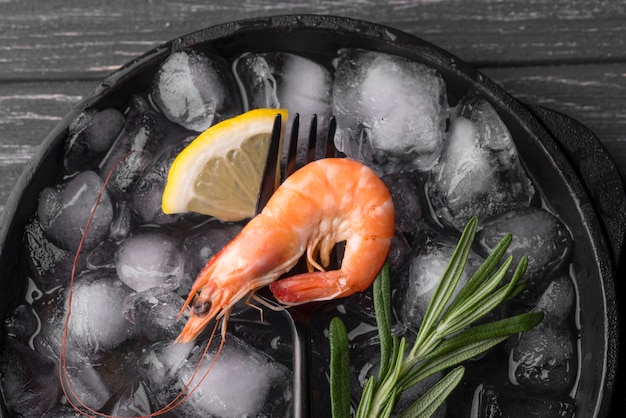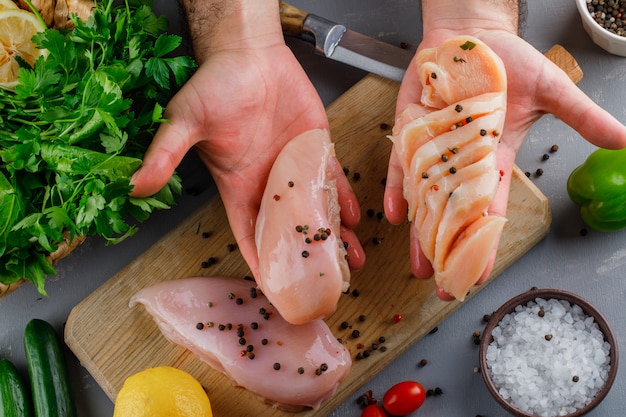Shrimp. Just the word conjures images of sizzling garlic butter, juicy morsels nestled in a vibrant tomato sauce, or a delicate skewer adorned with plump, pink prawns. They're a true culinary chameleon, effortlessly transforming from humble seafood to the star of any meal. But for some, the thought of cooking shrimp can feel daunting. Fear not, my friends! I'm here to guide you through the world of shrimp cooking, transforming you from a hesitant newbie to a shrimp-wielding pro.
My journey with shrimp began with my grandma's legendary shrimp scampi – a dish that holds a special place in my heart. It wasn't until years later, after countless experiments and a few kitchen mishaps, that I truly understood the art of cooking these delectable crustaceans. Now, I'm ready to share my hard-earned wisdom, making your shrimp adventures both delicious and easy. So, let's dive in!
(Part 1) Picking the perfect shrimp

The foundation of any fantastic shrimp dish lies in choosing the right shrimp. It's like picking the perfect ingredient for a cake – the quality matters. There's more to shrimp than meets the eye. We're not just talking about those tiny, pale specimens you find at the back of the supermarket freezer section! There's a world of flavour and texture waiting to be discovered, and the right shrimp can elevate your dish from good to truly spectacular.
What to Look For in Your Shrimp
Let's talk about what to look for when choosing your shrimp. First, you want to make sure they are firm to the touch. A good shrimp should feel springy and not mushy. Next, give them a good sniff. fresh shrimp should have a fresh, ocean-like scent. Avoid any that smell fishy or ammonia-like. Finally, pay attention to the colour. They should be uniformly coloured, with no discolouration or spotting. You want plump, juicy shrimp with a vibrant colour, a testament to their freshness and quality.
Unveiling the World of shrimp varieties
Shrimp come in all shapes and sizes, each with its unique character and flavour profile. Here's a peek into the fascinating world of shrimp varieties:
- Whiteleg Shrimp: These are your everyday, supermarket staples. They're typically affordable and a reliable option for everyday cooking. Think stir-fries, pastas, or a simple garlic butter sauce.
- Tiger Shrimp: Ah, the tiger shrimp! They're known for their striking tiger-like striping and delicate, sweet flavour. A little pricier, but well worth it for special occasions or when you want to impress. They're fantastic grilled or sautéed with a simple lemon and herb marinade.
- Black Tiger Shrimp: These behemoths are even larger than their tiger cousins, boasting a more intense flavour. They're the perfect choice for grilling, where their robust flavour can stand up to the smoky heat, or stir-frying where they add a satisfying chewiness to the dish.
- Pink Shrimp: Smaller than their larger relatives, these shrimp have a milder flavour and are perfect for salads, cocktails, or as a delicate addition to seafood platters.
Fresh vs. Frozen: A Weighing of the Options
Now, the age-old question: fresh or frozen? Both have their merits, and it really depends on your preferences and circumstances. I'm a firm believer in fresh shrimp, especially when sourced from a trusted fishmonger. The flavour is unparalleled, and the texture is wonderfully springy. However, frozen shrimp are a fantastic option if fresh isn't readily available or if convenience is paramount. Just make sure you choose a reputable brand with a good track record for quality freezing and storage. When thawing frozen shrimp, I recommend a gentle approach – either in the refrigerator overnight or submerged in a bowl of cold water. Never thaw shrimp at room temperature, as this can encourage bacterial growth and compromise the safety of your meal.
(Part 2) Preparing Your Shrimp for Culinary Glory

You've selected your shrimp, and now it's time for the pre-cooking ritual. Don't worry, this isn't a complex process. It's all about a little prep work that makes a big difference in the final outcome of your dish. Think of it as laying the groundwork for a masterpiece.
Cleaning Your Shrimp: A Simple Yet Crucial Step
Cleaning shrimp might seem intimidating, but it's actually a straightforward process. You'll need a sharp knife or kitchen shears for this task. First, remove the head and shell. While some folks prefer to leave the tail on for presentation purposes, it's entirely up to you. Next comes the slightly trickier part: removing the digestive tract, or “vein,” that runs along the back of the shrimp. You can easily do this by making a small incision along the back of the shrimp and gently pulling out the vein. This removes any potential bitterness and ensures a cleaner flavour. Now, your shrimp are ready for the next stage!
Elevating the Flavour with Marinades
Marination is a transformative process that infuses shrimp with intense flavour and creates a more succulent texture. It's a culinary trick that's simple to master, and the results are well worth the effort. The possibilities for marinades are endless, and you can get creative based on your taste preferences. Here are a few ideas to get you started:
- Citrusy Zing: Lemon, lime, and orange juice are natural allies for shrimp. Their bright acidity cuts through the richness of the seafood and creates a delightful tangy flavour. Combine citrus juice with herbs like parsley, cilantro, or oregano for an added punch.
- Herby Delight: Fresh herbs are an absolute game-changer when it comes to shrimp marinades. Think parsley, cilantro, basil, thyme, rosemary, or even a blend of your favourites. Their vibrant aromas and flavours infuse the shrimp with a delicate complexity.
- Spicy Heat: For those who prefer a little kick, consider adding a touch of heat to your marinade. A sprinkle of chili flakes, a dash of hot sauce, or a dollop of sriracha can elevate the flavour profile and add a delightful warmth.
Let your shrimp soak in the marinade for at least 30 minutes, or even overnight for a deeper infusion of flavour. Then, you're ready for the main event: cooking!
(Part 3) cooking techniques: Unveiling the Best Methods for Shrimp

Shrimp are like culinary chameleons, adapting to a variety of cooking methods. From the sizzle of a pan to the smoky embrace of a grill, each technique brings out a different facet of their flavour and texture. Let's explore some of the most popular and rewarding methods for cooking shrimp:
Pan-Frying: Achieving Crispy Perfection
Pan-frying is a classic method for cooking shrimp, yielding a beautifully crispy exterior while retaining the shrimp's tender, juicy interior. You'll need a hot pan, a good quality oil with a high smoke point (like avocado oil or vegetable oil), and your favourite seasonings. I often add a squeeze of lemon juice and a couple of minced garlic cloves for an extra layer of flavour. Pan-frying is quick and easy, and the results are consistently delicious.
Grilling: Embracing Smoky Flavour
Grilling is a fantastic way to infuse shrimp with a delightful smoky flavour, perfect for summer barbecues or a cosy dinner on the patio. Use medium heat for grilling shrimp, and keep a close eye on them as they cook quickly. A simple marinade of olive oil, lemon juice, and herbs is all you need to create a truly delicious grilled shrimp experience.
Baking: A Healthy and Versatile Option
Baking shrimp is a healthy and convenient option, requiring no additional oil. Simply toss the shrimp with your favourite seasonings and bake them in a preheated oven until they're cooked through. You can also add vegetables like bell peppers, onions, or mushrooms for a more substantial and flavourful dish.
(Part 4) Mastering cooking times: A Guide to Perfectly Cooked Shrimp
Cooking times are crucial when it comes to shrimp, as they cook incredibly quickly. Overcooked shrimp becomes tough and rubbery, while undercooked shrimp can be a food safety risk. Here's a handy guide to cooking times for different methods:
| Cooking Method | Cooking Time |
|---|---|
| Pan-Frying | 2-3 minutes per side |
| Grilling | 2-3 minutes per side |
| Baking | 10-12 minutes at 400°F (200°C) |
| Boiling | 3-5 minutes |
| Sautéing | 2-3 minutes |
These are just guidelines, and the actual cooking time might vary depending on the size of your shrimp and the heat of your cooking method. Always check the shrimp to ensure they are cooked through. The shrimp should be opaque and pink when they're done. If you're unsure, use a meat thermometer to check the internal temperature, which should be 145°F (63°C).
(Part 5) Presenting Your Culinary Creation: Serving Up Shrimp with Flair
Your shrimp is cooked to perfection, and now it's time to present your culinary masterpiece to the world! From elegant platters to casual skewers, there are countless ways to showcase the beauty and flavour of your shrimp.
Seafood Platter: A Feast for the Eyes and Palate
A seafood platter is a classic and elegant way to serve shrimp. Pair them with other seafood delights like crab, scallops, or mussels, and add a touch of Mediterranean flair with fresh bread, aioli, and lemon wedges.
pasta dishes: A Symphony of Flavours
Shrimp is a natural addition to pasta dishes, adding a touch of protein and a burst of flavour. Try them in a creamy alfredo sauce, a spicy tomato sauce, or a light pesto sauce. You can even create your own unique shrimp pasta creation, letting your culinary creativity take flight!
Salads: A Light and Refreshing Option
Shrimp adds a protein punch and a delicious flavour to salads. Toss them with fresh greens, tomatoes, cucumbers, and your favourite dressing for a light and refreshing meal. shrimp salads are perfect for a warm summer day or a light lunch.
Skewers: A Fun and Versatile Approach
Shrimp skewers are a fun and versatile appetizer or main course. Thread them onto skewers with your favourite vegetables like bell peppers, onions, zucchini, or cherry tomatoes. Grill, bake, or pan-fry them for a delectable and visually appealing dish.
(Part 6) shrimp recipes: A culinary adventure Awaits
Let's turn up the heat and delve into some delicious shrimp recipes that will inspire your culinary creativity. These are some of my personal favourites, guaranteed to tantalize your taste buds and leave you craving for more.
Garlic Butter Shrimp Scampi: A Classic with a Touch of Elegance
This classic Italian dish is a symphony of flavours, made with simple ingredients that combine to create a truly magical experience. You'll need some fresh shrimp, garlic, butter, white wine, lemon juice, and parsley. Simply sauté the shrimp in butter and garlic, deglaze the pan with white wine, and finish with a squeeze of lemon juice and a sprinkle of fresh parsley. Serve over pasta or rice for a satisfying and flavourful meal.
Spicy Coconut Shrimp Curry: A culinary journey to the Tropics
This curry is a true testament to the versatility of shrimp. It's bursting with flavour and heat, and it's guaranteed to tantalize your taste buds. You'll need shrimp, coconut milk, curry paste, onions, garlic, ginger, and your favourite spices. Simmer the shrimp in a creamy coconut milk sauce until they are cooked through. Serve over rice or naan bread for a delicious and comforting meal that will transport you to a tropical paradise.
Grilled Shrimp with Mango Salsa: A Taste of Summer
This light and refreshing dish embodies the essence of summer. You'll need grilled shrimp, fresh mango, red onion, cilantro, lime juice, and chili flakes. Combine the mango, onion, cilantro, lime juice, and chili flakes for a vibrant salsa that will tantalize your taste buds. Serve the grilled shrimp over a bed of rice or quinoa, and top with the mango salsa for a dish that's both beautiful and delicious.
(Part 7) Tips and Tricks for Shrimp Success
Here are some tips and tricks that I've learned over the years to help you achieve shrimp perfection in your kitchen:
- Don't Overcook: Shrimp cook quickly, so don't overcook them! Overcooked shrimp become tough and rubbery, losing their delicate texture and flavour. A quick sear in the pan or a few minutes on the grill is all they need.
- Choose the Right Oil: Use a high-heat oil like avocado oil or vegetable oil for pan-frying or grilling shrimp. These oils have a higher smoke point, meaning they can withstand high temperatures without burning or producing unpleasant fumes.
- Season Generously: Don't be shy with the seasonings! Shrimp takes on flavours beautifully, so let your culinary creativity run wild. Experiment with herbs, spices, citrus zest, and even a touch of chili flakes for a bold flavour profile.
- Embrace the Lemon Squeeze: A simple squeeze of lemon juice brightens up the flavour of shrimp, adding a tangy touch that complements the delicate sweetness of the seafood.
- Don't Forget the Parsley: A sprinkle of fresh parsley adds a pop of colour and freshness to your shrimp dishes, enhancing the visual appeal and providing a fragrant touch.
(Part 8) FAQs: Decoding the Mysteries of Shrimp Cooking
Here are some frequently asked questions about shrimp cooking, answered to help you become a confident shrimp maestro:
1. How do I Know When Shrimp is Cooked?
Shrimp is cooked when it turns opaque and pink, the flesh becomes firm, and it is no longer translucent. You can also use a meat thermometer to check the internal temperature, which should be 145°F (63°C).
2. Can I Eat the Shell of Shrimp?
Some people enjoy eating the shell of shrimp, but it's generally not recommended. Shrimp shells can be tough and difficult to digest. It's best to remove the shell before cooking.
3. How Long Can I Store Shrimp in the Refrigerator?
Fresh shrimp can be stored in the refrigerator for 1-2 days. Frozen shrimp can be stored in the freezer for up to 3 months. Make sure to store shrimp properly to prevent spoilage. Keep fresh shrimp in an airtight container and frozen shrimp in a freezer-safe bag or container.
4. What are the Best Ways to Defrost Shrimp?
The best way to defrost shrimp is in the refrigerator. It takes about 12-24 hours for shrimp to thaw in the refrigerator. You can also defrost shrimp in a bowl of cold water. Never defrost shrimp at room temperature, as this can encourage bacteria growth and compromise the safety of your meal.
5. What Wines Pair Well with Shrimp?
Shrimp pairs well with a variety of wines, but some of the best options include:
- Sauvignon Blanc: This dry white wine has a crisp acidity that cuts through the richness of the shrimp, creating a harmonious flavour balance.
- Pinot Grigio: This light-bodied white wine has a refreshing flavour that complements shrimp dishes without overpowering their delicate sweetness.
- Rosé: A dry rosé wine can also be a delightful pairing for shrimp, especially if it's grilled or seasoned with herbs. The fruity notes of rosé enhance the flavour of the shrimp without being too heavy.
There you have it, my fellow culinary adventurers! Shrimp cooking 101: from raw to delicious. I hope this guide has demystified the world of shrimp and given you the confidence to create culinary masterpieces in your own kitchen. Go forth, experiment, and enjoy the delightful world of shrimp cooking!
Everyone is watching

Corn on the Cob: The Ultimate Guide to Perfectly Cooked Ears
Healthy MealsAh, corn on the cob. Just the name evokes images of sunny days, barbecues, and that sweet, juicy flavour that ...

Perfect Pork Roast Oven Cooking Time: A Guide to Delicious Results
Healthy MealsThere's something truly satisfying about a perfectly roasted pork. The aroma alone is enough to make your mout...

Ham Cooking Time: How Long to Bake, Smoke, or Boil a Delicious Ham
Healthy MealsAh, ham. It's a classic, isn't it? A real crowd-pleaser, especially around holidays. And when done right, it'...

Scallops: The Ultimate Guide to Perfect Cooking
Healthy MealsAh, scallops. Those delicate, sweet, and utterly delicious morsels of the sea. They hold a special place in my...

Spaghetti Squash: The Ultimate Guide to Cooking and Serving
Healthy MealsRemember that time you saw spaghetti squash at the supermarket, looking all bumpy and strange, and thought, "W...
